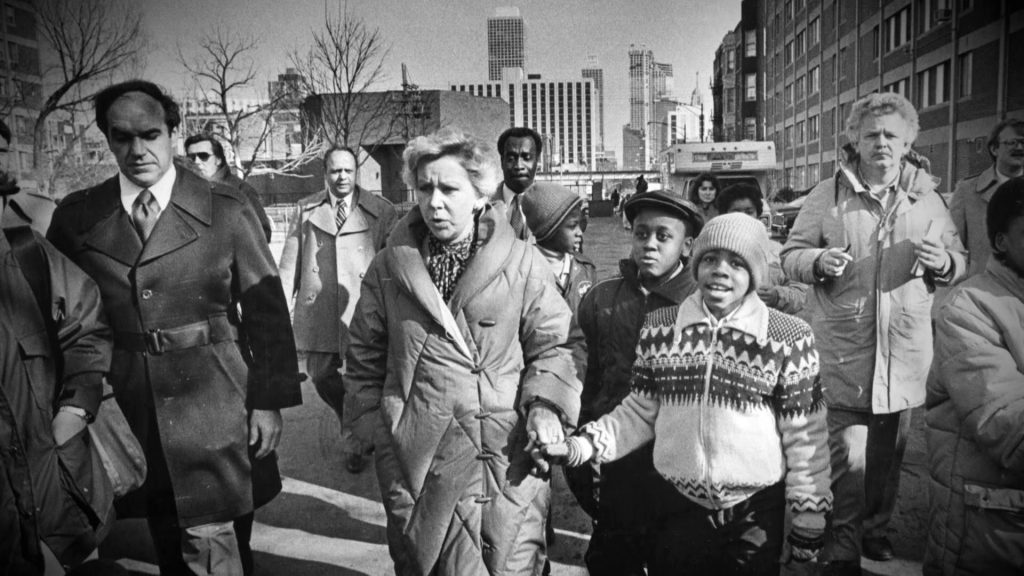
To listen to this reflection as a podcast, click here.
Long-time residents of Chicago can still remember when their mayor moved into hell.
Actually, Jane Byrne and her husband moved into the area on the Near North Side that had long been known as Little Hell.
That name went back to the 1850s, when Irish immigrants lived in dismal conditions near a gas refinery that filled the air with noxious fumes and shot pillars of fire into the sky. By the 1930s, the same real estate was identified as “Death Corner” on a map that plotted Chicago’s mob activity during the heyday of Al Capone. More than 50 gangland murders were documented in the neighborhood.
Things began to look brighter for the area in 1942 when city authorities decided to build some of America’s first public housing units. A series of rowhouses and high rises were named after Mother Frances Cabrini (1850-1917), an Italian-American sister who served the urban poor and became our nation’s first Catholic saint. In 1962, the William Green Homes were built nearby, which honored the memory of one of Chicago’s most famous labor leaders.
Thus was born the Cabrini-Green housing projects, a name that is now associated almost exclusively with crime and hopelessness.
Sociologists will no doubt spend the next century trying to understand how the bright idealism of public housing took such a dark turn. Cabrini-Green was home at one point for at least 15,000 people – essentially a small town embedded within a big city. In the 1980s, the population was overwhelmingly Black, poor, and young. One survey revealed that only 9% of the residents were employed.
Cabrini-Green became a central staging area for gang activity and drug deals. The high-rise elevators (when they worked) were dangerous places to enter at any hour of the day. Those who walked up the stairwells risked being mugged or raped. Chain-link fencing was bolted to the outside of the balconies so residents would stop hurling trash to the courtyards below – and to prevent people from either falling or being pushed to their deaths. At one point, the interior trash chutes were packed all the way up to the 15th floor.
Snipers regularly assumed positions on the top floors so they could take potshots at rival gang members on the street. Police and first responders tended to keep their distance, designating the projects a “No-Go” area, which only accelerated the dangers for those who had to live there. When fires broke out, the burned-out apartments were simply boarded up.
It’s no surprise that many authorities concluded Cabrini-Green was so unsafe as to be uninhabitable.
That’s when Jane Byrne decided to do something dramatic.
Running as a reform-minded Democrat in 1979, she had been elected mayor “for all Chicago,” winning more than 82% of the vote – still a record for the city. She and everyone else were appalled that between January and March 1981, 11 people had been murdered in the projects. She wrote in her 2004 memoir, “How could I put Cabrini on a bigger map? Suddenly I knew – I could move in there.”
On March 26, 1981, she and her husband Jay McMullen moved into a fourth-floor apartment in one of the high-rises, vowing to stay “as long as it takes to clean it up.”
She didn’t come alone.
Police and bodyguards stayed with them at all times. On the first night, police officers made multiple arrests of individuals who were planning to have a shootout in the mayor’s building. The rear entryway of her unit was welded shut, so potential attackers could approach only by means of the front entrance. As historian Laura Marriott notes, “This had the unwelcome side effect of creating a fortified area for gangs to use after her departure.”
The mayor stayed only three weeks. Her political rivals snickered that it had all been just a publicity stunt. McMullen, for his part, regularly dropped in on Cabrini-Green, where he coached a baseball and basketball team for street kids. But all in all, it was a lot harder to live in hell than anyone imagined.
Mercifully, the projects were finally condemned and then torn down in 2011. Now they’re just an exceedingly painful memory.
Jayne Byrne isn’t the only person who moved into hell.
Jesus did, too.
He took up residence in a world that has never outgrown its foolishness and cruelty, whose residents find endlessly creative ways to divide others into Winners and Losers, and whose Religious Establishment considered it their duty to put him to death. He lived amongst people who flunked Spiritual Discernment 101 – men and women who failed to recognize his true identity.
As the Gospel writer John puts it, “He was in the world, and the world was there through him, and yet the world didn’t even notice. He came to his own people, but they didn’t want him…. The Word became flesh and blood and moved into the neighborhood” (John 1:9-10, 14, The Message).
It proved to be a very dangerous place.
But he didn’t come with bodyguards. Or police protection. Nor did he stay for just three weeks.
Jesus spent at least 30 years in this world, and something like three years touching lepers, confronting hypocrites, forgiving enemies, and teaching the same things over and over again to dimwitted disciples like us.
But it wasn’t a stunt. And the most amazing thing of all?
Jesus clearly thought it was worth it.
